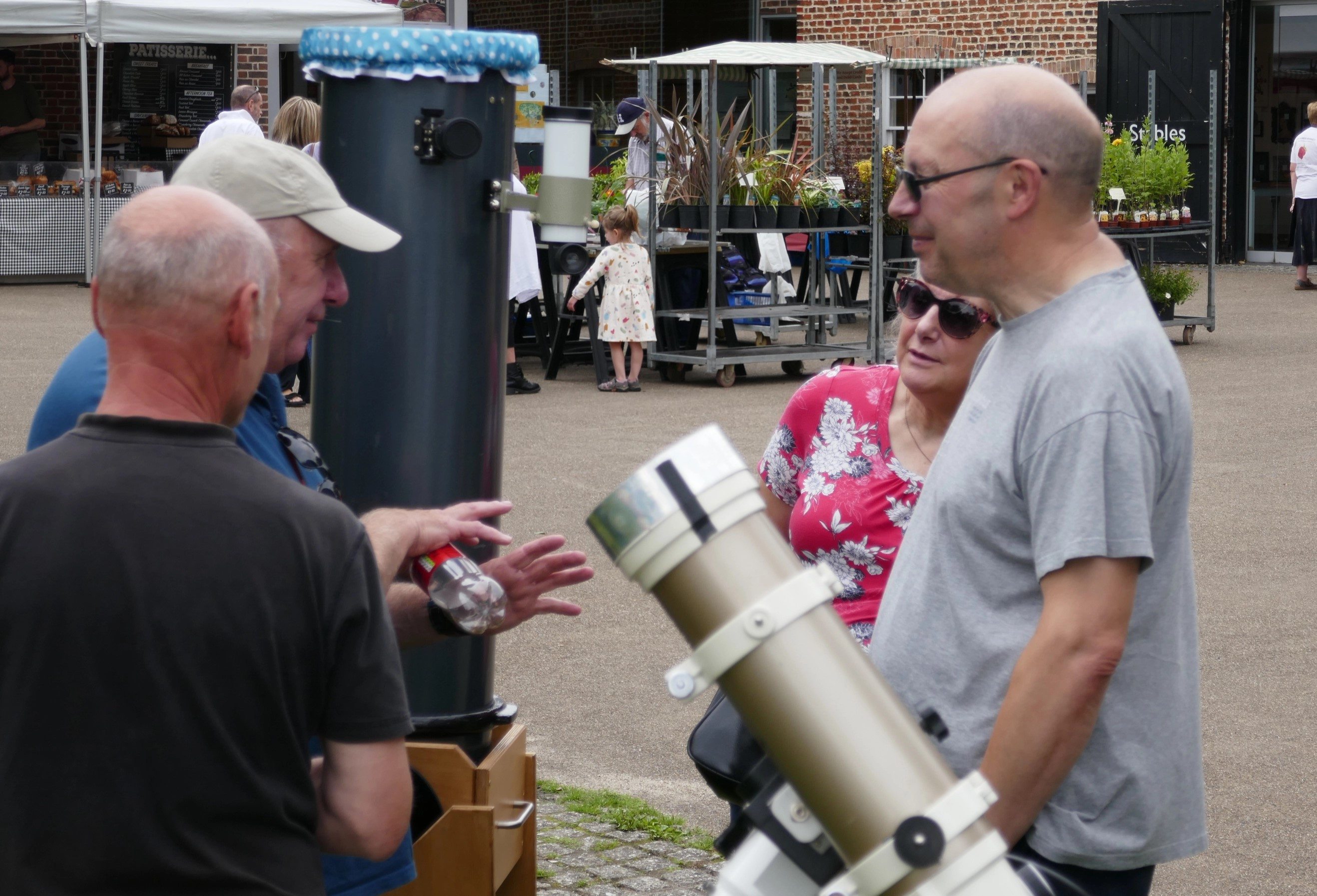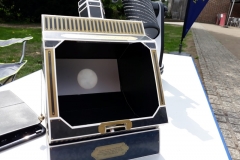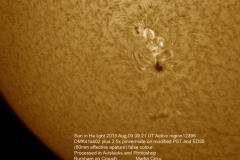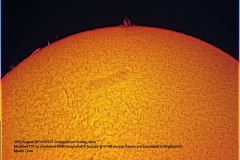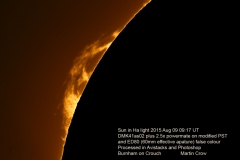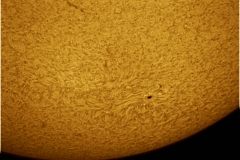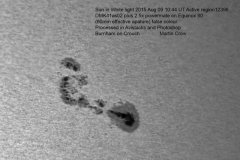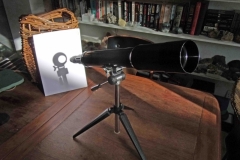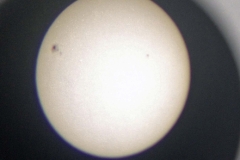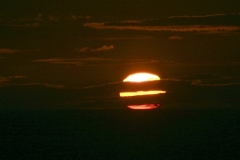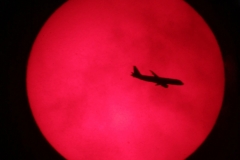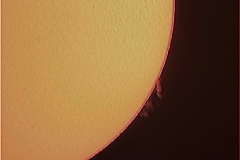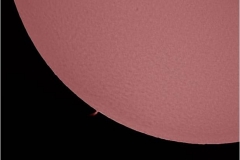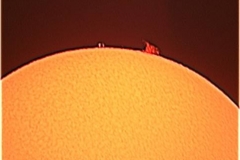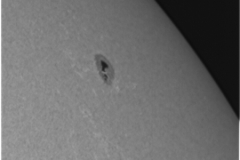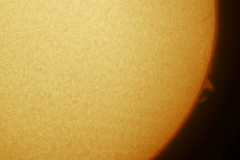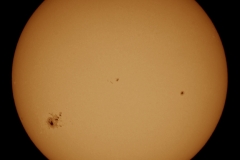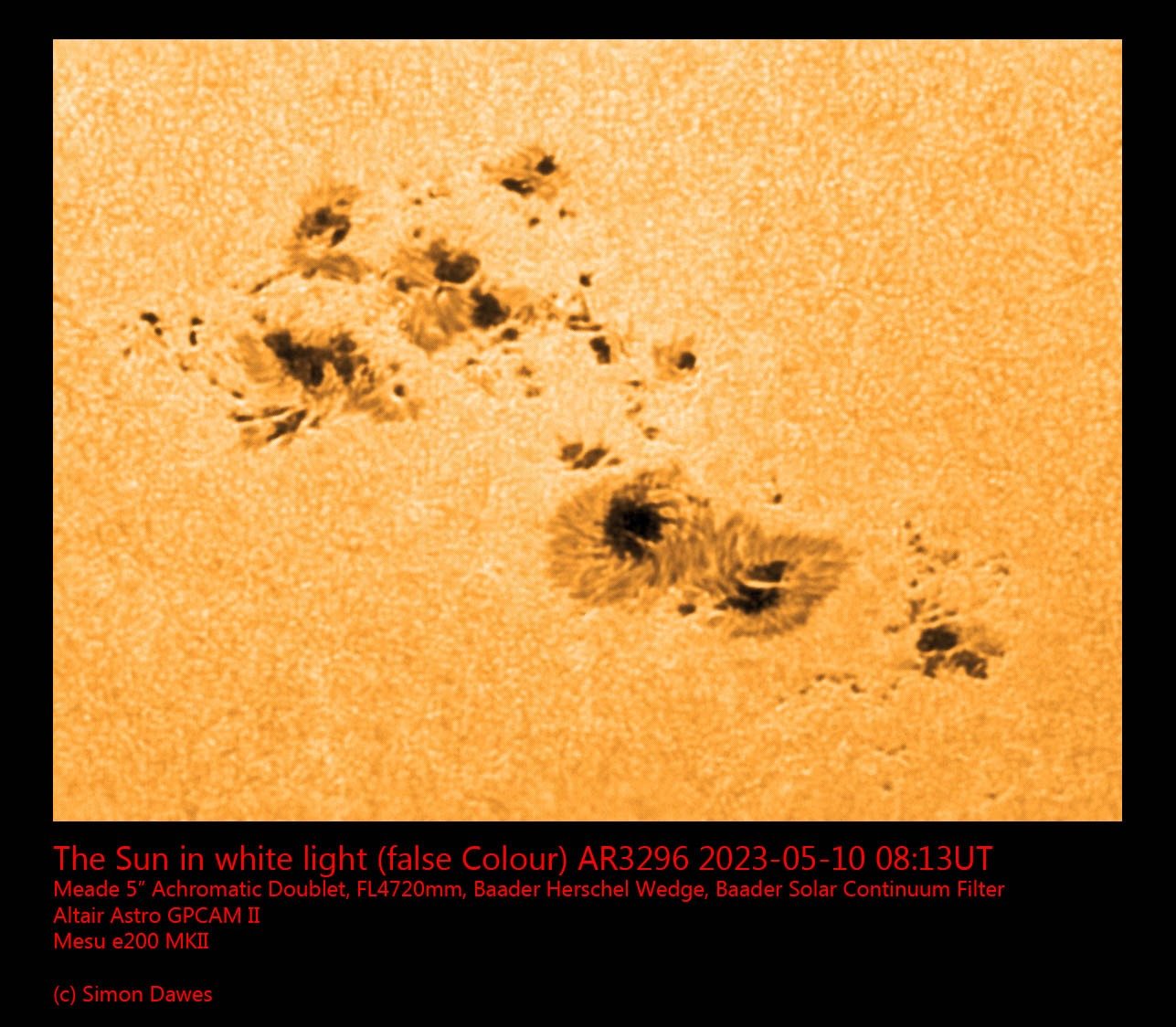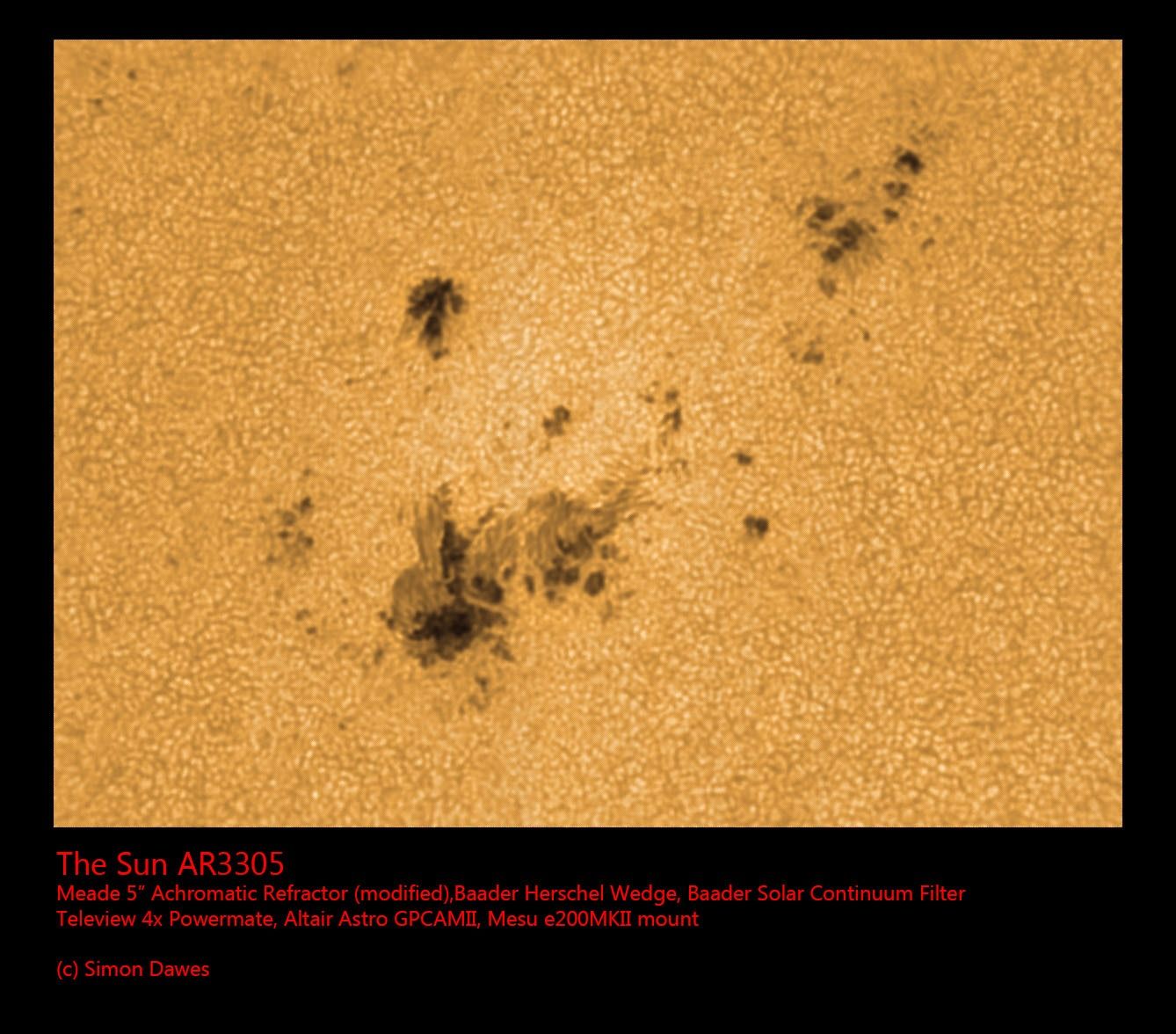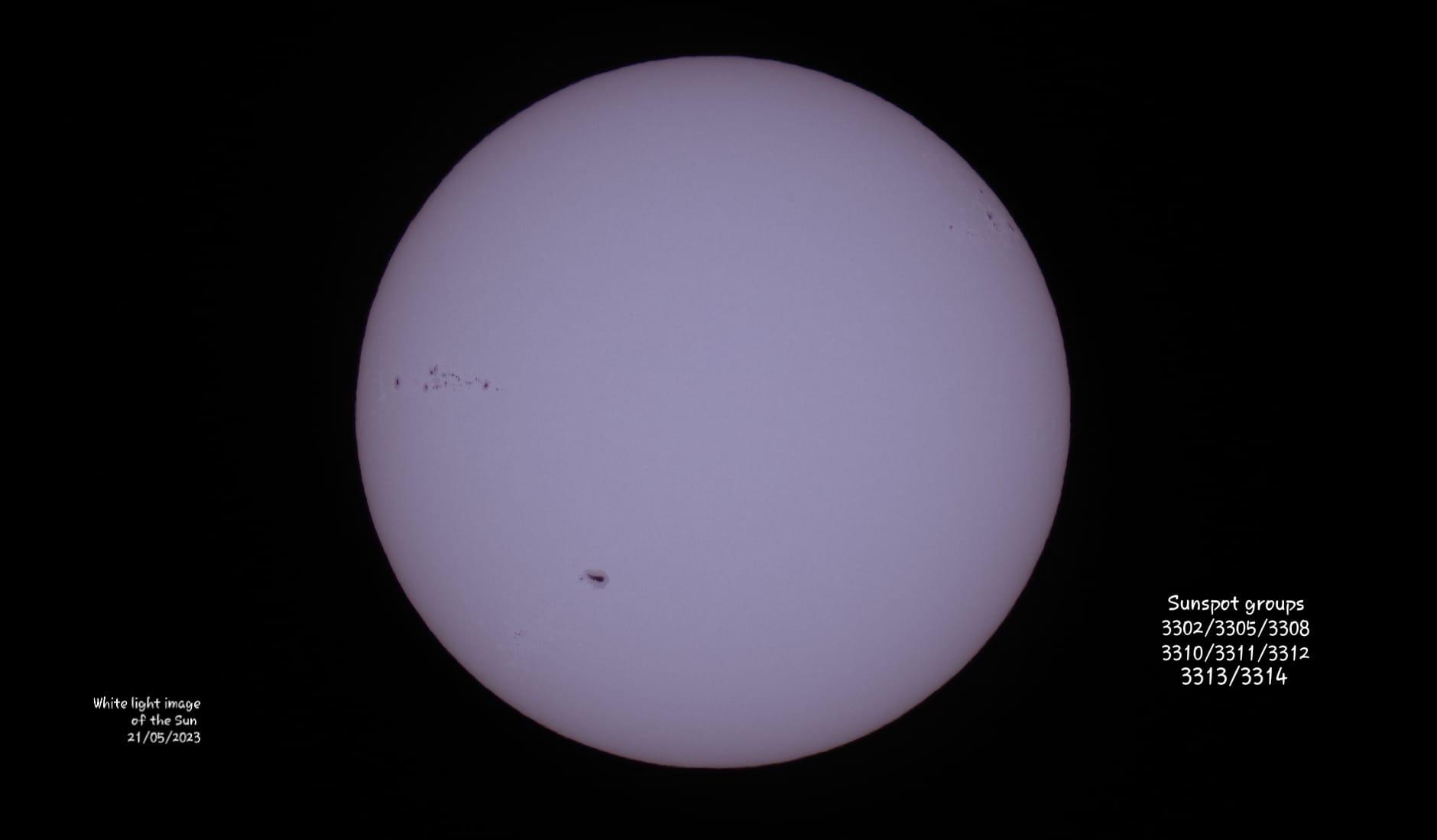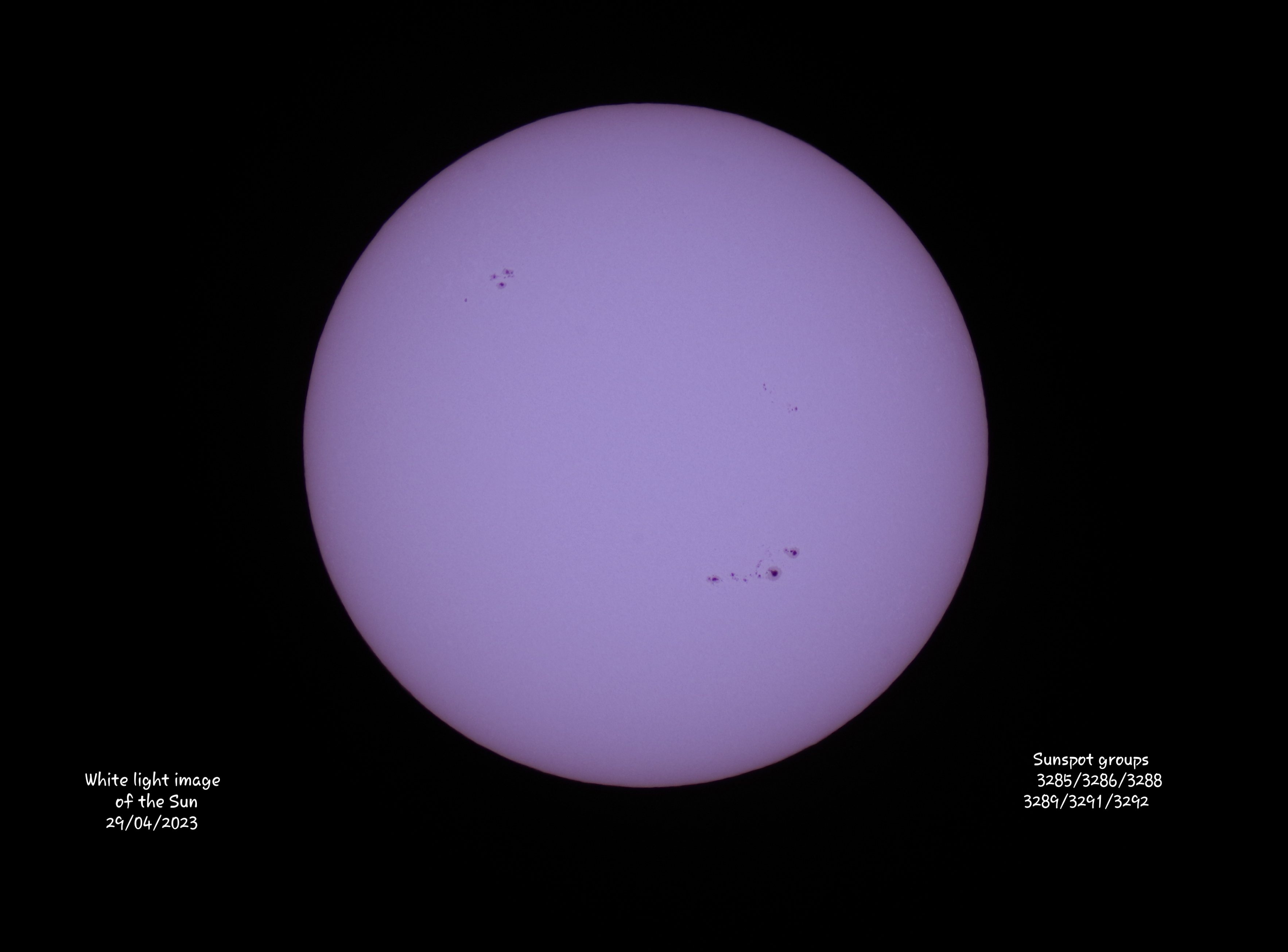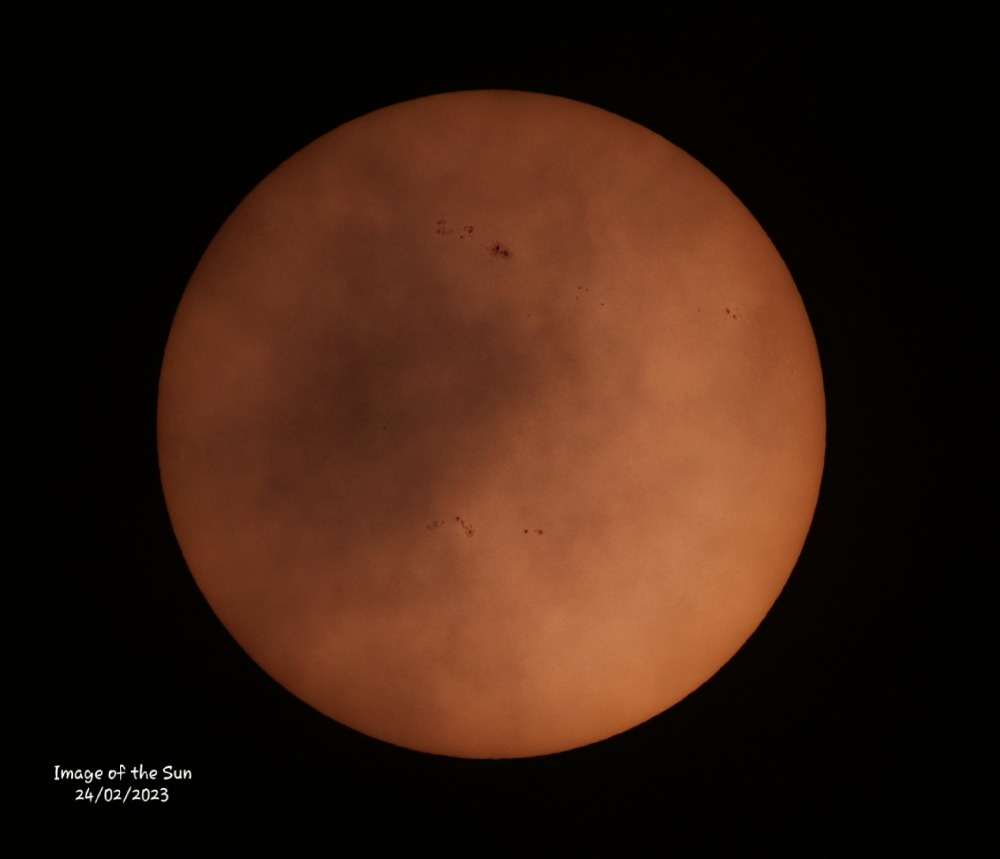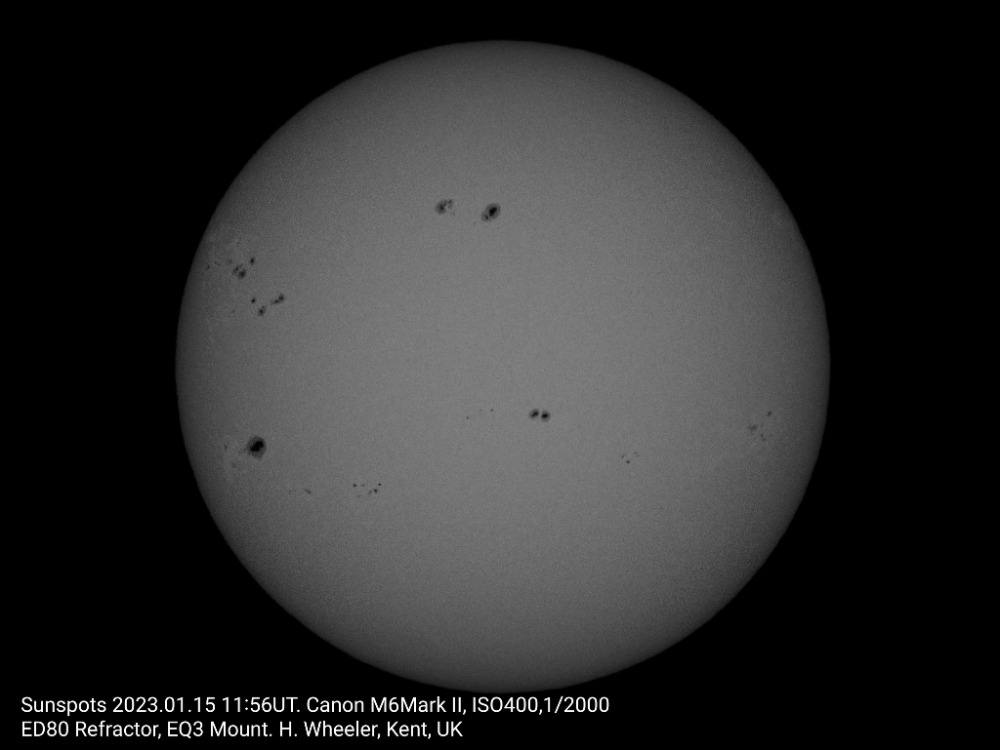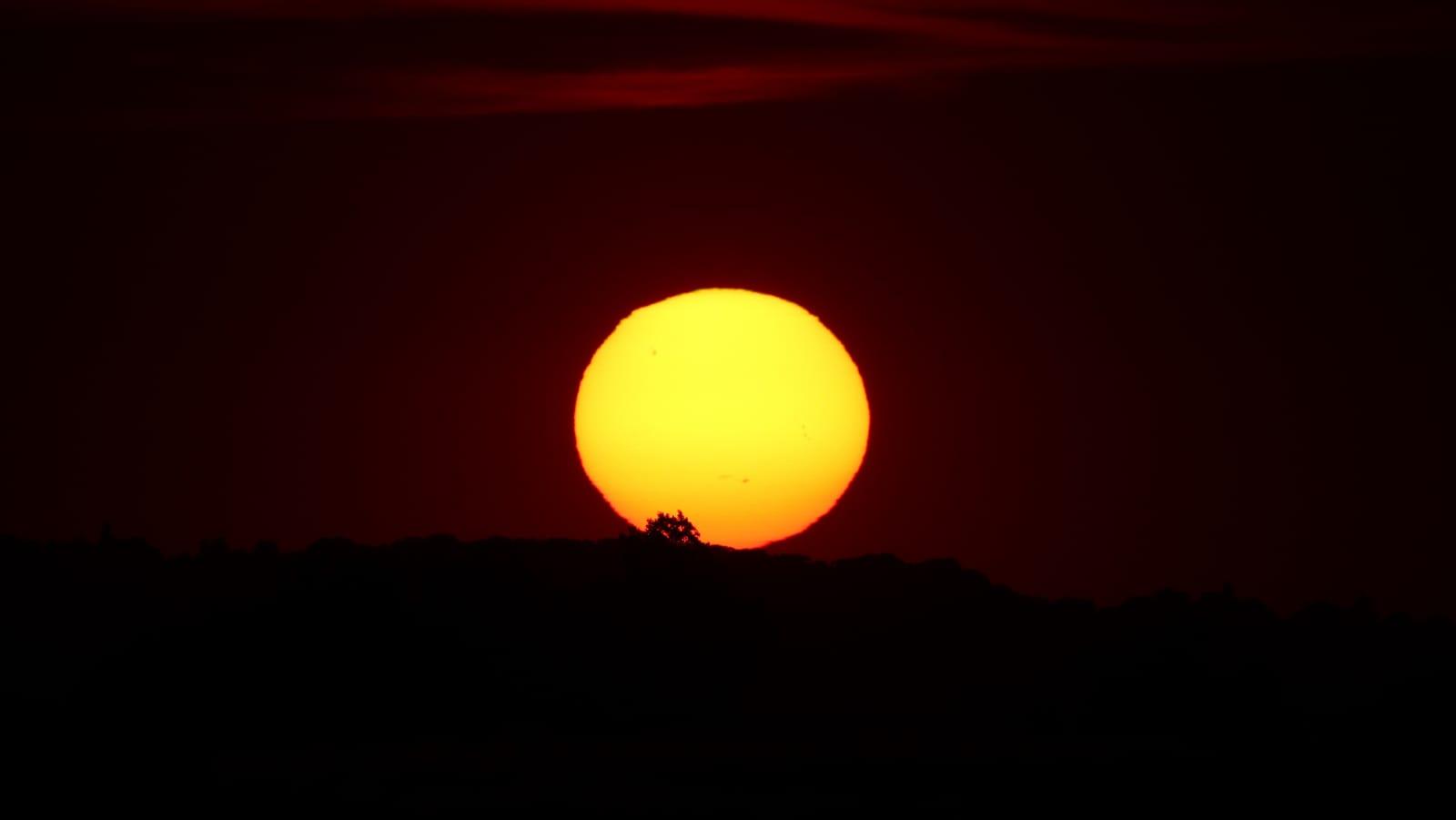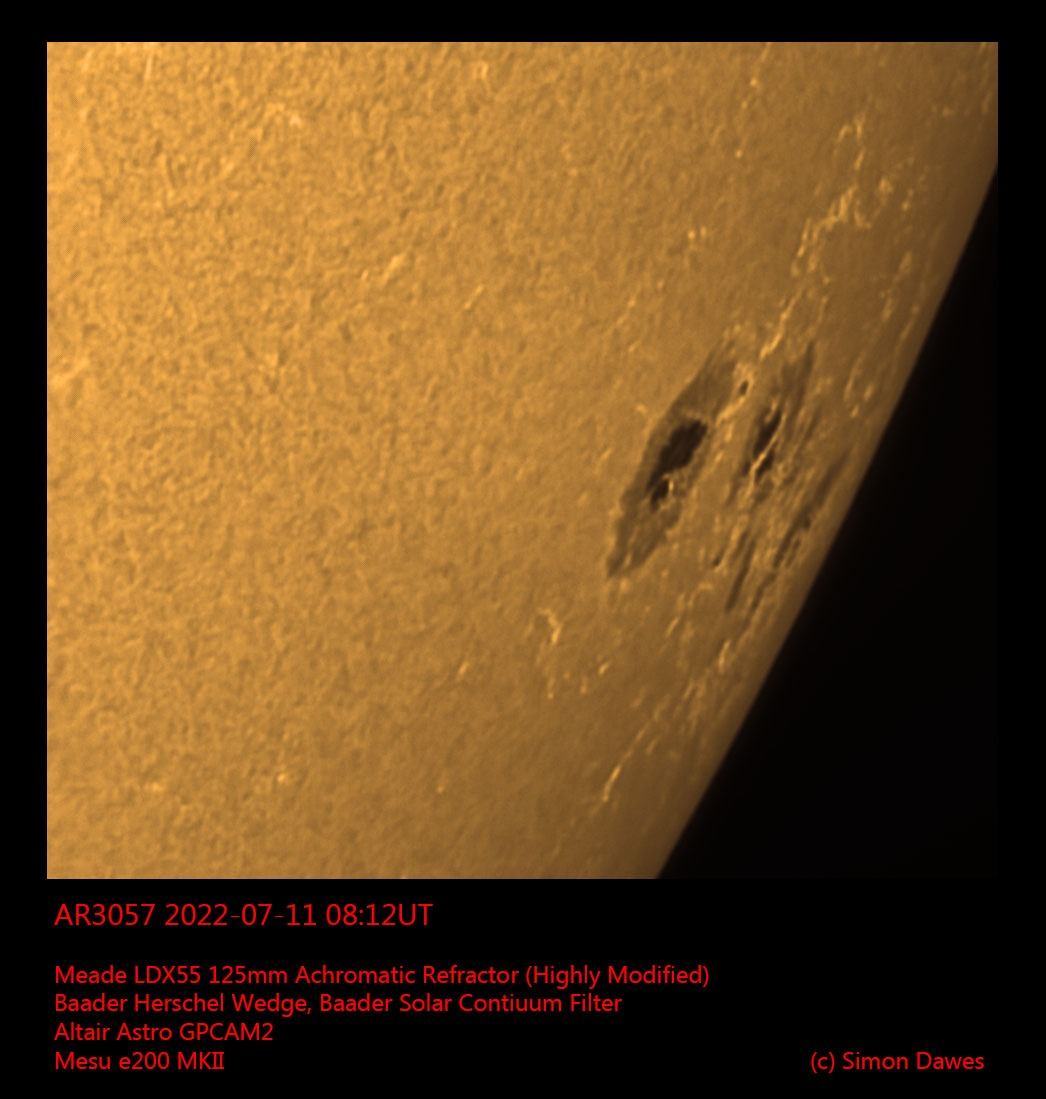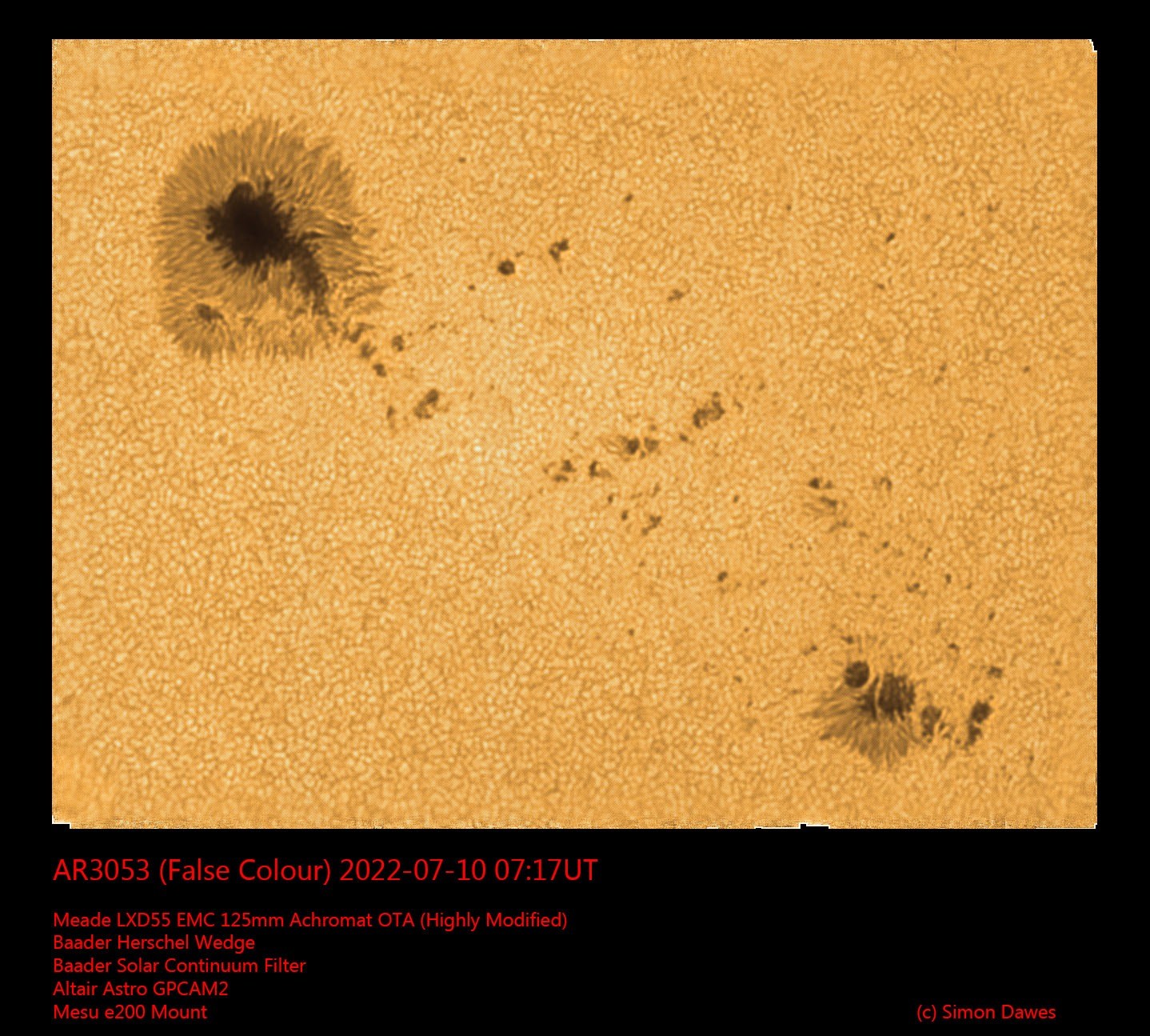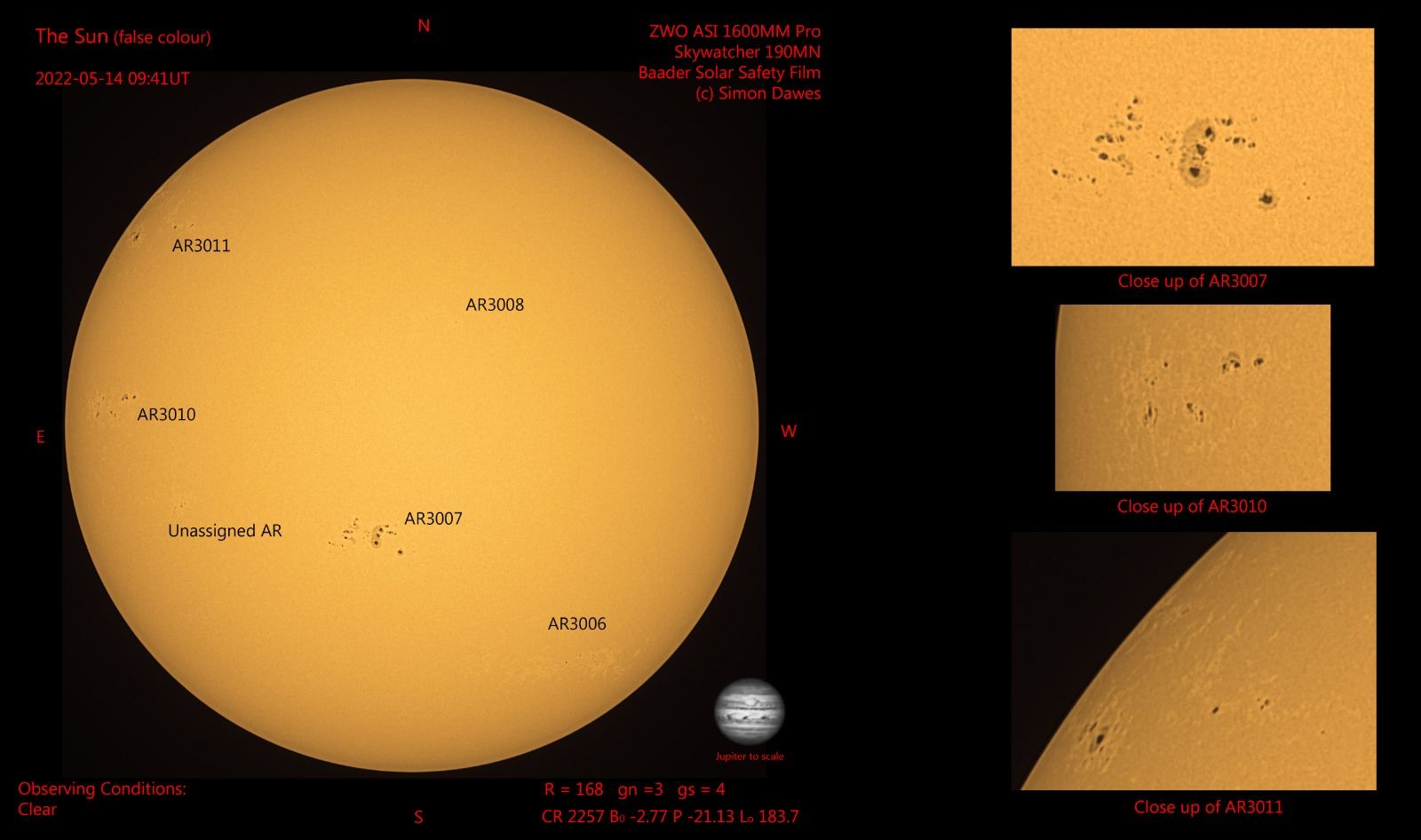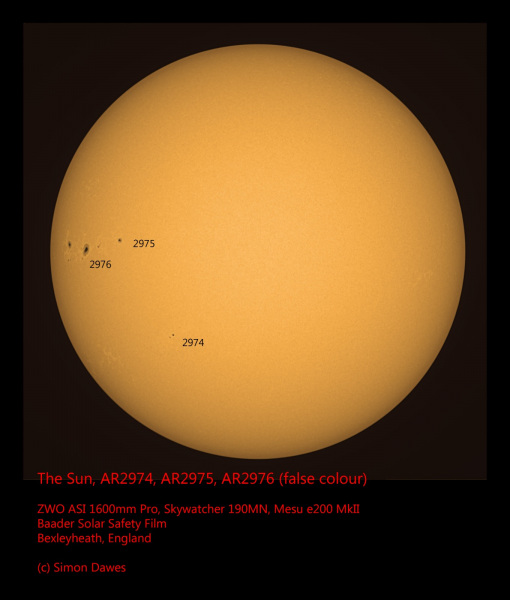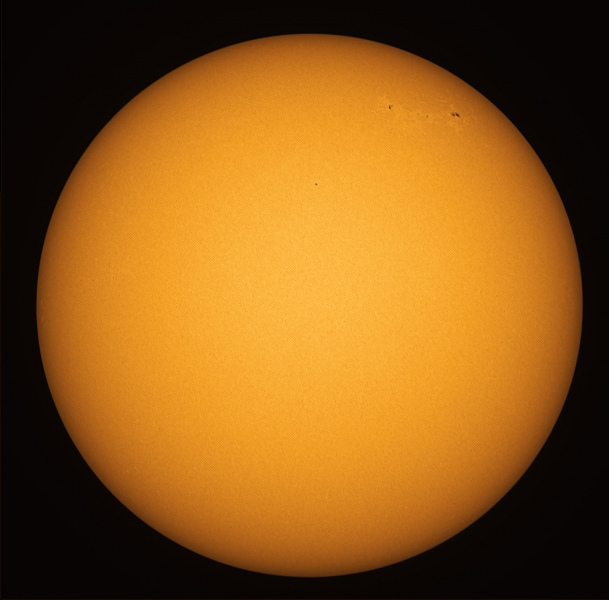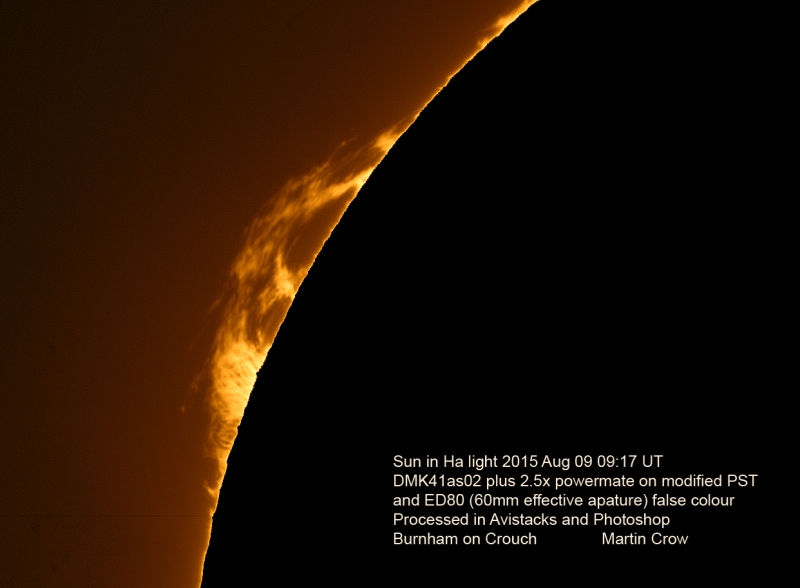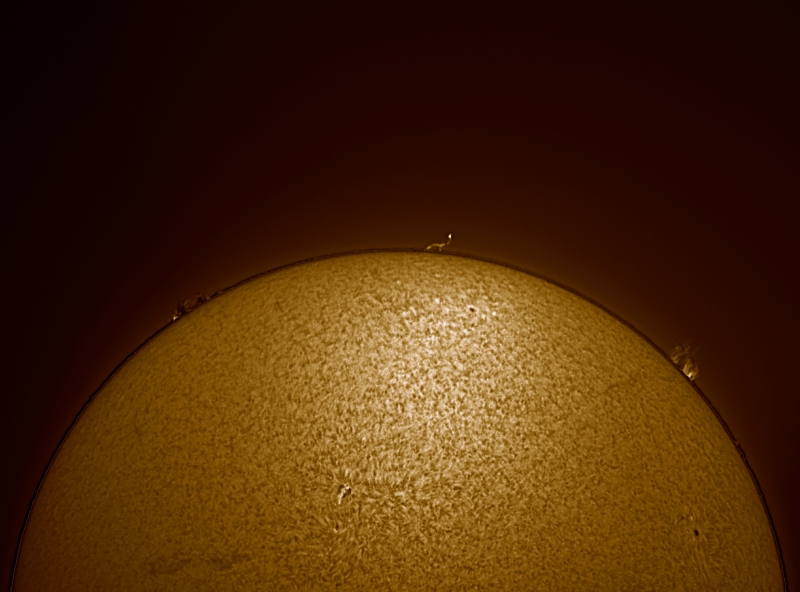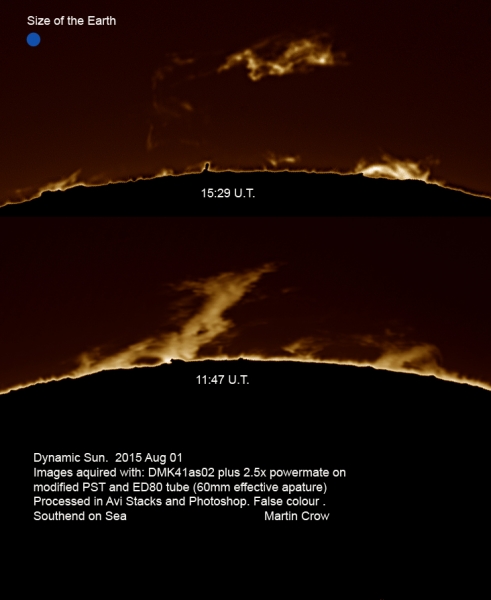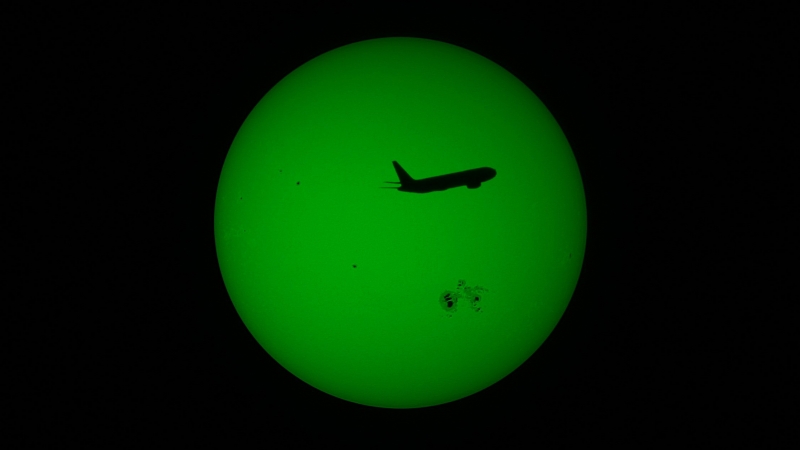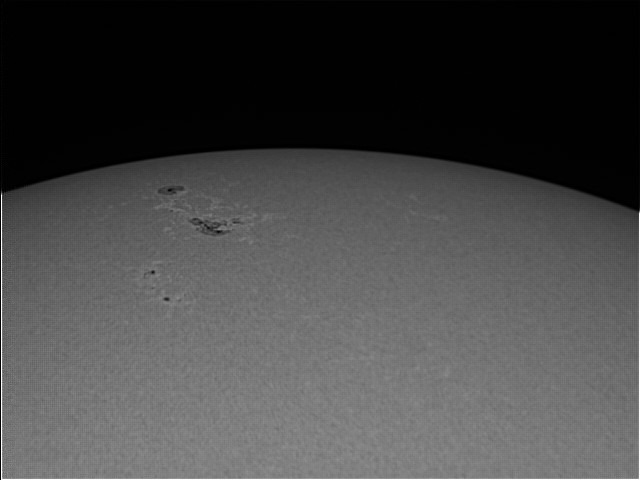Observing the Sun:
If you have never viewed the Sun before PLEASE ask one of our members to show you how to do this safely and read the page on Solar Safety before attempting any kind of viewing of the Sun!
Sunspot Numbers
When observing the Sun consider taking a count of active areas and calculating the relative sunspot number (R) and reporting these to the BAA Solar Section
The Sun has an obliquity to the ecliptic of 7.25° if you record your solar observations as drawings then you should use the appropriate Stonyhurst disc as a template, this will allow you to identify the latitude of the sunspot at any time of year.

Live Image from SOHO
Active Areas or Sunspot groups (g)
This is a count of all the active areas on the disk, if there is a sunspot, however small, this is an active area (group) if sunspots are separated by at least 10° then they are separate active areas, a large spread out area is still considered a single AA unless there are clear centres of activity within the larger area, then they are counted separately.
Relative Sunspot Number (R)
To find the Relative Sunspot Number count all the individual sun spots call this number, f, then the relative sun spot number, R = (10 x g) + f

Example: 3 active areas, 35 spots, R=(10×3) +35 = 65 (no other spots on disk)
Reporting
Regardless how infrequent your observing the BAA Solar Section are happy to receive your observations, these can be in the form of images, drawings and monthly reports.
Useful Filters
The Sun can be observed through different filters and these have advantage and disadvantages, please speak to other Members of the Society or the BAA Solar Section for detailed information.
Baader Solar Safety Film – White light filter, very cheap but effective full apature filter, turns any telescope into a solar telescope.
Herschel Wedge – White light Filter, very expensive but Members tend to get better results with these than with solar safety film.
Solar Continuum Filter – Only for use with a Herschel wedge or Solar Safety film, increases the contrast of surface features.
Hydrogen Alpha Solar Scopes – Many makes of these available, they are very expensive (~£600 for the cheapest) but will enable you to see solar flares and other features not visible with white light.
CaK Solar Scopes – Many makes of these available, they are very expensive (~£600 for the cheapest) but will enable you to image solar flares and other features not visible with white light, not suitable for visual observations.
The Sun by Jim Burchell
NEVER LOOK AT THE SUN DIRECTLY. Please click here for solar observing safely.
A lovely collection of white light images of the Sun taken by member Jim Burchell in May & June this year; showing several large sunspots. Jim took the images using a Pentax KP camera attached to a 102 mm Altair refactor fitted with a solar filter and then processed in Snapseed.





Solar Observing at the Pavilion – 11th May 2024
NEVER LOOK AT THE SUN DIRECTLY. Please click here for solar observing safely.

After a fantastic night of observing the Aurora, several CMHASD members took the opportunity to observe the huge sunspot AR664 that caused it, at the Parsonage Lane Pavilion the following day. Below are a selection of photos from that afternoon.
The white light image of the Sun below was taken by member George Buckberry using a Canon EOS760D attached to a Celestron MakC90 fitted with a Baader 5.0ND Solar filter. All mounted on a Sky-Watcher Alt-Az Mount and Tripod.











Thank you to Diane, Sonia & Jim for sharing your photos.
CMHASD Solar Observing at Hall Place & Gardens – 5th May 2024
NEVER LOOK AT THE SUN DIRECTLY. Please click here for solar observing safely.
On Sunday 5th May 2024 the team from CMHASD set themselves up for the first of our two Solar Observing events at Hall Place & Gardens and what a glorious day it was to be out solar observing.

Members of the public were invited to do some solar observing which was enthusiastically accepted by those who were keen to look at the sun using our scopes. The Sun put on a good display having several complex sunspots for the public to view.
Five telescopes were set up to observe the Sun safely. First; a table-top Celestron Firstscope 76mm Newtonian fitted with a home-made solar filter through which many of the public were able to see the numerous sunspot groups, this was a low budget telescope and easy to use.

There were 3 smart scopes set up; two Seestar S50’s and a Dwarf II. The 2 images of the Sun below were taken by the smart scopes. The first was taken by CMHASD Secretary Dr Mike Rushton using a Dwarf II smart scope and the second taken by member Terry Miles using a Seestar S50 smart telescope. Both images were captured whilst Mike & Terry were helping at Hall Place.

Dwarf II smart telescope (1″ aperture!) 30 x 1/200sec subs at gain 0 with a ND6 Solar filter.

The fifth telescope set up was a Celestron C90 Maksutov Cassegrain telescope, focal length 1250mm, 90mm objective lens (corrector plate) using a 32mm eye piece which gave a full view of the Sun’s disk. This was on a Sky Watcher heavy duty tripod on which was mounted a William Optics wedge on which was mounted a iOptron Sky Guider Pro tracking mount and finally the Mak mounted on top. The Celestron was set up for visual observation only so fitted with a Baader 5ND solar filter, no imaging was done.

Our pitch was on the grass at the end of the path from the main entrance to the gardens, and we were quite close to the hard standing outside the art gallery and café. With the date being chosen to coincide with the Farmers’ Market, we experienced good foot-fall and our flag was prominent for visitors as they arrived.

The Crayford team returns again later in July for our second session but there’s no doubt this first visit to Hall Place for Solar Observing in 2024 was a great success and the Society would like to thank all those members who helped on the day 😀

Thank you also to John Archer, John Howarth, Dr Mike Rushton and Terry Miles for sharing your photos with us.

*** CMHASD will be back at Hall Place on Sunday 7th July 2024 to do some more Solar Observing with the public. Please do come and join us! ***
Our Sun – 21st & 29th April 2024
NEVER LOOK AT THE SUN DIRECTLY. Please click here for solar observing safely.
Two fab images of our Sun taken by member Jim Burchell on the 21st & 29th April 2024. Details of how Jim captured the Sun is on the 1st image. Please note a solar filter was used too.
Sun on 21st April 2024 by Jim Burchell

For comparison; below is the Sun with the Sunspots numbered taken from Spaceweather.com on 21st April 2024.

Ref:https://www.spaceweather.com/archive.php?view=1&day=21&month=04&year=2024
The Sun on 29th April 2024 by Jim Burchell

For comparison; below is the Sun with the Sunspots numbered taken from Spaceweather.com on 29th April 2024.

Ref:https://www.spaceweather.com/archive.php?view=1&day=29&month=04&year=2024
The Sun – 18th April 2024
NEVER LOOK AT THE SUN DIRECTLY. Please click here for solar observing safely.
A super collection of Sun images taken on the 18th April 2024.
The 1st image below was taken by Dr Mike Rushton using a Dwarf II smartscope. Mike took 30 x 1/200sec images which were stacked, gain 0 + solar filter.

For comparison, below is the Sun image from Spaceweather.com on the 18th April and has the Sunspots numbered.

The next 5 images below of the Sun were taken by member Simon Dawes. Details of how Simon acquired his images are on some of the photos.





The Sun – 24th March 2024
NEVER LOOK AT THE SUN DIRECTLY. Please click here for solar observing safely.
A super image of the Sun taken on 24th March 2024 by member Honor Wheeler.
Honor captured the white light image of the Sun using an ED80 Refractor fitted with a solar filter, EQ3-pro Synscan mount, 2x Barlow, Canon M6 II. Exp1/6400s and ISO400.
Below Honor’s image is an image of the Sun on the same day with the sunspots labelled taken from Spaceweather.com.


Photo Ref: https://www.spaceweather.com/archive.php?view=1&day=24&month=03&year=2024
Spaceweather.com reported ”Yesterday, the sun produced a solar flare so strong, it took two sunspots to make it. Sunspots AR3614 and AR3615 exploded in tandem on March 23rd (0130 UT), directing their fire straight at Earth. A National Solar Observatory telescope in Australia recorded the double blast.
The explosion from AR3614 (top) was so violent it seemed to rip the fabric of the sun, while AR3615 (bottom) followed very close behind with a less intense blast of its own.
While this may seem like an incredible coincidence, it probably didn’t happen by chance. Researchers have long known that widely-spaced sunspots can explode in tandem. They’re called “sympathetic solar flares.” Occasionally, magnetic loops in the sun’s corona fasten themselves to distant pairs of sunspots, allowing explosive instabilities to travel from one to the other. This has apparently happened to AR3614 and AR3615.
Some sympathetic flares are so much alike, they are considered to be twins. Yesterday’s double-blast was not a perfect twin, but close enough. It shows that the two sunspots are linked, raising the possibility of more double-flares…”
The NASA Solar Dynamics Observatory captured the sequence and it can be viewed in this movie.
The Sun by Jim Burchell – 24th March 2024
NEVER LOOK AT THE SUN DIRECTLY. Please click here for solar observing safely.
A super image of the Sun taken by member Jim Burchell. The image is showing an extremely large Sunspot group AR3615 in the middle of the Sun.
Jim took the single image using a Pentax KP camera attached to a 102 mm Altair refactor fitted with a solar filter and then processed in Snapseed.
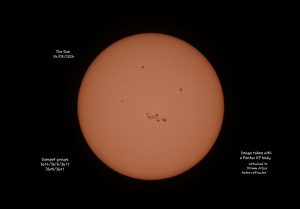
The Sun – 25th Feb 2024 by Jim Burchell
NEVER LOOK AT THE SUN DIRECTLY. Please click here for solar observing safely.
A splendid image of the Sun taken on the 25th February 2024 by member Jim Burchell. Jim captured the image using a Seestar S50 smart scope fitted with a solar filter and processed in Snapseed. The giant sunspot AR3590 that can be seen on the Sun in Jim’s image was more than ten times wider than Earth when the image was taken.

The Sun by Jim Burchell – 1st March 2024

The Sun by Jim Burchell – 23rd Nov 2023

Development of Sunspot AR3395 by Simon Dawes
A nice set of images showing how the Sunspot AR3395 developed over 5 days as it moved across the Sun in August by member Simon Dawes.

The Sun and the Wilson Effect – Simon Dawes
NEVER LOOK AT THE SUN DIRECTLY. Please click here for solar observing safely.
On the 26th September 2023 member Simon Dawes imaged the Sun. One of his images of the sunspots on the Sun that day showed an interesting effect called the ‘Wilson Effect’. The Wilson effect is the perceived depression of a sunspot’s umbra or centre in the Sun’s photosphere.

Sunspot AR3443 showing the ‘Wilson Effect’

https://britastro.org/section_information_/solar-section-overview/wilson-effect-observers-challenge
Solar Observing at Hall Place & Gardens – Sunday 6th August 2023

NEVER LOOK AT THE SUN DIRECTLY. Please click here for solar observing safely.
Sunday 6th August 2023 – What a glorious day to be out solar observing which is what Crayford Manor House Astronomical Society Dartford (CMHASD) where doing at Hall Place & Gardens in Bexley.
What a busy day it was too! Several telescopes were set up to observe the Sun safely and members of the public were invited to do some solar observing which was readily accepted by many. The Sun put on a good display having several sunspots and prominences for the public to view.
Chairman John Archer wrote ”On Sunday 6th August, the team from CMHASD set ourselves up for the first of our two Solar Observing events at Hall Place & Gardens.
The forecast was for early morning sun, followed by sunny intervals until around 11am, but cloudy conditions until the arrival of rain at 4pm. Given that our timeslot was effectively 11am – 3pm, we were nervous to say the least!
Our pitch was on the grass at the end of the path from the main entrance to the gardens, and we were quite close to the hard standing outside the art gallery and café. With the date being chosen to coincide with the Farmers’ Market, we experienced good foot-fall and our flag was prominent for visitors as they arrived.
At one point we had around a dozen members in attendance and the public were treated to displays of sunspots the like of which we haven’t seen for years. Whilst the big Dob Anita was an immediate attraction, we had Tinie, two solar projectors and a range of H-Alpha and white light filtered scopes with which to demonstrate safe solar observing to a very interested public.
Of particular note was the filtered refractor which Honor had set up with a digital camera attached, affording visitors a proper “live view” of the surface of the sun. Each of the scopes were able to display clear views of sunspots such was their size and quantity. This solar cycle has certainly picked up in terms of activity and although the local forecast was for cloudy conditions, we very much lucked out in terms of clear spells so the public were very fortunate that during the period while the Farmers’ Market was trading, we were able to keep them entertained and educated.
The Crayford team returns again later in August for our second session but there’s no doubt this first visit to Hall Place for Solar Observing in 2023 was a great success.”
Below is an image of the Sun on the 6th August 2023 taken by member Honor Wheeler. The Sun was very active with lots of sunspots. Image acquired using an ED80 Refractor, EQ3 Synscan mount, Canon M6 MarkII, 2x lens Barlow and ISO200/ exp 1/1250s.

CMHASD will be back at Hall Place on Saturday 19th August 2023 to do some more Solar Observing with the public. Please do come and join us!
Thank you to John Archer, Diane Clarke and Honor Wheeler for sharing your photos of the day with us.
Our Active Sun by Simon Dawes
More stunning images of our active Sun taken by member Simon Dawes in the later half of July 2023. Details of how Simon acquired his images are on the photos.
For more information about the Sun, its structure, atmosphere, sunspots, solar cycle and magnetosphere click on https://solarsystem.nasa.gov/solar-system/sun/in-depth/
12th July 2023


26th July 2023

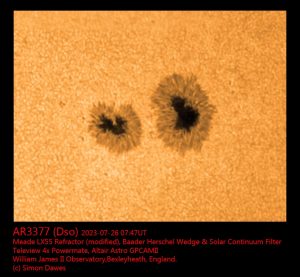


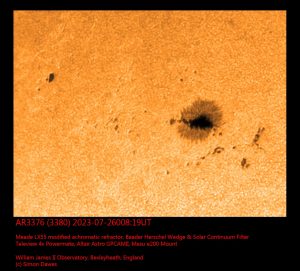

29th July 2023
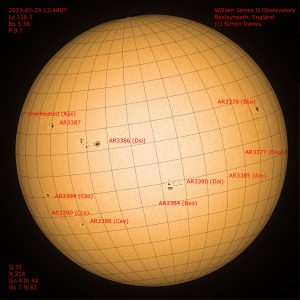


The Sun in June 2023 by Simon Dawes
NEVER LOOK AT THE SUN DIRECTLY. Please see our Solar Observing safety page at crayfordmanorastro.com/solar-safety/
Lots of stunning images taken by member and trustee Simon Dawes of our Sun on 4 days during the month of June. Details of how Simon acquired the images are on the photos.
9th June 2023




16th June 2023


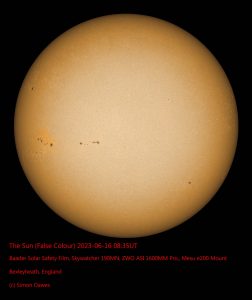

19th June 2023

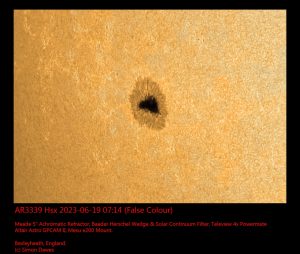




21st June 2023






The Sun – 7th July 2023
NEVER LOOK AT THE SUN DIRECTLY. Please see our Solar Observing safety page at crayfordmanorastro.com/solar-safety/
CMHASD members Jim Burchell, Honor Wheeler and Simon Dawes took the opportunity to observe and image the Sun on Friday 7th July 2023 and below are their super images.
The Sun is very active with many sunspots and one so large it was seen from Mars; yes that is correct – from Mars.
The very large sunspot AR3363 which has just emerged over the Sun’s southeastern limb was spotted by the Mars rover Perseverance several days before we did. On July 2nd, the rover’s mast-mounted stereo camera MASTCAM-Z tilted up to the sky above Jezaro crater and photographed a deep-black dot on the solar disk. For more information about this; see https://www.spaceweather.com/archive.php?view=1&day=07&month=07&year=2023.
Jim Burchell

Honor Wheeler
The Sun in Hydrogen Alpha.
Composite of 2 photos one for the disc and one for prominences details, then layered in Snapseed.
Canon M6 Mark II, Coronado PST,
EQ3 Synscan mount, x2 Barlow
ISO200, 1/25s
2023.07.07 12:48UT

Image enhanced to show some of the Sun’s prominences.

Solar Sunpsots in White light
Canon M6 Mark II, 80mm Refractor, EQ3 Synscan mount, Baader Solar filter, x2 Barlow.
ISO100, 1/800s.
2023.07.07 12:31UT
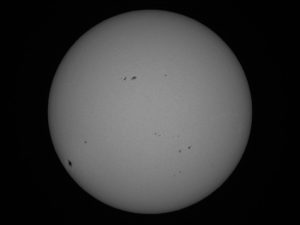
Sunspot AR3363 appearing over the southeastern limb of the Sun.

Simon Dawes
Details of how Simon acquired his images are on the photos.



Sun full disk in White light – 12 active regions. Q=30 and R = 225 so pretty active today. Click here to see a full version https://britastro.org/observations/observation.php?id=20230707_113215_4d5fba6e58719cdf

For the latest information about the Sun’s activity check out Spaceweather.com
The Sun – May 2023
NEVER LOOK AT THE SUN DIRECTLY. Please see our Solar Observing safety page at crayfordmanorastro.com/solar-safety/
The latest images of our active Sun by members Simon Dawes and Jim Burchell.
Simon’s 3 images below were taken on the 18th May 2023. Details of how Simon acquired the images are on the photos.



Jim’s image was taken on the 21st May 2023

The Sun by Simon Dawes – 10th & 16th May 2023
NEVER LOOK AT THE SUN DIRECTLY. Please see our Solar Observing safety page at crayfordmanorastro.com/solar-safety/
A fantastic collection of images of our Sun taken by Simon Dawes on the 10th & 16th May 2023 from North Kent, showing lots of sunspots 🙂
Details of how Simon acquired his images are on the photos.
The Sun on the 16th May 2023


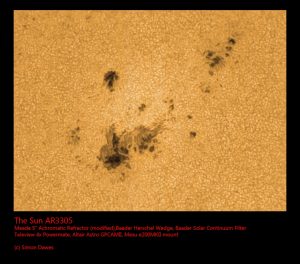
The Sun on the 10th May 2023





The Sun – 29th April 2023 by Jim Burchell

Images by Jim Burchell – 23rd to 25th Feb 2023
Member Jim Burchell was busy out and about towards the end of February photographing our stunning sky and below is a selection of his superb images.
Orion, Taurus and the Pleiades taken on the 23rd Feb from the CMHASD pavilion, Sutton-at-Hone.
Image was taken with a Pentax KP on a static tripod, F6.3, 30 sec, 18 MM and iso 800.

Crescent Moon on the 24th Feb.

The Sun taken on the 24th Feb.
NEVER LOOK AT THE SUN DIRECTLY. Please see our Solar Observing safety page at crayfordmanorastro.com/solar-safety/

Crescent Moon with Jupiter & Venus on the 25th Feb.
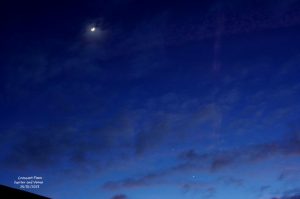
Active Sun – 10th February 2023 by Jim Burchell
NEVER LOOK AT THE SUN DIRECTLY. Please see our Solar Observing safety page at crayfordmanorastro.com/solar-safety/
A super image of an active Sun captured by member Jim Burchell on the 10th February 2023 showing Sunspots 3213 to 3221. Jim took the image with a Pentax KP attached to 102mm Altair Astro refractor using a solar filter.

Below is an image of the Sun on the 10th Feb 2023 taken from Spaceweather com showing the sunspots with their allocated numbers. Credit: SDO/HMI

Enormous Sunspot AR3190 – 20th Jan 2023
NEVER LOOK AT THE SUN DIRECTLY. Please see our Solar Observing safety page at crayfordmanorastro.com/solar-safety/
A fantastic image of the Sun taken on the morning of the 20th January 2023 by member Jim Burchell. The image was taken by Jim using a pentax KP attached to 102mm Atair Astro refractor fitted with a solar filter. At the 4 O clock position from the centre of the Sun is the large sunspot AR3190. AR3190 is one of the largest sunspots of Solar Cycle 25 so far, at almost five times the diameter of Earth.

Boxing Day Sun in Hydrogen Alpha by Honor Wheeler
NEVER LOOK AT THE SUN DIRECTLY. Please see our Solar Observing safety page at crayfordmanorastro.com/solar-safety/
A stunning image of the Sun in H-alpha on 26th Dec 2022 by Honor Wheeler.
The image was acquired by Honor at 20221226_1212UT using a Canon M6 Mark II and Personal Solar Telescope (PST).
Honor wrote ‘This image of the Sun was taken using a Coronado personal solar telescope or PST which shows the Sun’s H-alpha surface features. These features include Sunspots, Filaments and Prominences. In this image there are a number of large Prominences around the edge of the Sun’s disc and on the surface these can be seen as the dark Filaments snaking across the face of the Sun. The bright areas are Sunspots which are active regions which can flare brightly as you can see at the top right of the disc. Most H-alpha images that show Sunspot and Prominence detail and activity are composite images and are photographed separately then combined in editing software. In this case however, I was lucky and I managed to capture both Prominence, surface structures and activity in one single photo.’

New Society Solar Projector built by member George Buckberry – Society Meeting – 2023.01.26
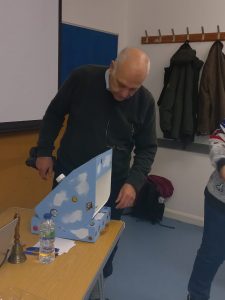
Member George Buckberry with his hand built Solar Projector
Last week following our Society meeting on the 26th January 2023, we learned about the design and construction of a table-top solar projector built by George Buckberry. After all of the effort involved in building the projector, George has very kindly donated it to the Society for use by members and also as a means of educating the public at one of our outreach events. Thank you George for your very kind donation.
Below is a link to George’s PowerPoint presentation of how George built the Solar Projector in the form of a PDF file which you can download.
SolarScope Design & Build by George Buckberry of CMHASD

Very Active Sun – 2023 Jan 15 – Honor Wheeler.
NEVER LOOK AT THE SUN DIRECTLY. Please see our Solar Observing safety page at crayfordmanorastro.com/solar-safety/
On the morning of Sunday 15th January 2023, CMHASD member Honor Wheeler captured this absolutely stunning image of the Sun. As you can see it was very active and still is! Details of how Honor acquired her brilliant image are on the photo.
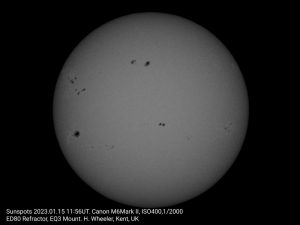
The information below is taken from the website Spaceweather.com

Picture above shows the Sun on 15th January 2023 – taken by the Solar Dynamics Observatory with the Sun spots labelled.
”’…I can’t remember having seen so many sunspots together; indeed, the sunspot number is high. If solar activity continues at this pace for the rest of January, the monthly sunspot number will reach a 20-year high. And Solar Maximum is still ~2 years away. Contrary to predictions, Cycle 25 is shaping up to be a good one, after all.”
17th Jan 2023
”NAKED-EYE SUNSPOT: One of the biggest sunspots in years (AR3190) is crossing the solar disk–and you can see it with the naked eye. “Be sure to use safe solar glasses to protect your eyes,” says Bum-Suk Yeom of Iksan, South Korea. “I tried it myself today, and I could see the sunspot clearly.”
As shown in Yeom’s infographic, the sunspot is four times wider than Earth. It’s twice as big as any other spot on the sun, visible to the naked eye, and a magnificent target for backyard solar telescopes.
Best of all, it’s about to explode. AR3190 has an unstable ‘beta-gamma-delta’ magnetic field that harbors energy for X-class solar flares. Any eruptuions will be geoeffective because the sunspot is almost directly facing Earth.” ”
Unusual Sunspot AR3088 – 26th August 2022 by Simon Dawes
NEVER LOOK AT THE SUN DIRECTLY. Please click here for solar observing safely.
On the morning of the 26th August 2022 member Simon Dawes imaged 3 of the sunspots on the sun – AR3086. AR3088 and AR3089 and superb images they are too. Sunspot AR3088 however looked a little bit different from the usual sunspots seen and indeed it was according to Spaceweather.com – see below.
Details of how Simon acquired the images are on each photo.
Unusual sunspot AR3088
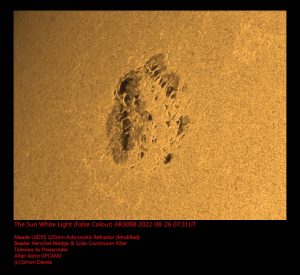
Screen shot from Spaceweather.com explaining why sunspot AR3088 looks unusual….
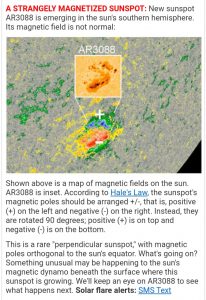
https://www.spaceweather.com/archive.php?view=1&day=25&month=08&year=2022
Sunspot AR3089
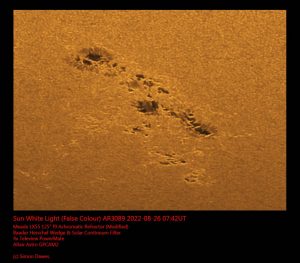
Sunspot AR3086

The Sun – 22nd August 2022
Our sun on the 22nd Aug 2022 imaged by member Simon Dawes. Despite seeing being very poor that morning; a great image was achieved by Simon showing an active sun. Details of how Simon acquired the images are on the main photo.
NEVER LOOK AT THE SUN DIRECTLY. Please click here for solar observing safely.

Sunspot AR3085

Sunspot AR3081

The Sun – 15th July 2022
More super images of the Sun by member Simon Dawes taken on the 15th July 2022 showing the Sun speckled with sunspots. Details of how Simon took the images are on the pictures.
NEVER LOOK AT THE SUN DIRECTLY. Please click here for solar observing safely.




Sunspots at Sundown – 13th July 2022
Whist waiting for the Moon to rise on the 13th July 2022 members Honor Wheeler and Jim Burchell photographed the Sun as it set with just their cameras. When they looked at their images they saw that they had captured some of the massive sunspots on the Sun that day too in their photos. In both images you can see sunspot AR3055 bottom middle right and sunspot AR3057 top left on the Sun. In Honor’s image you can also see Sunspot AR3053 middle right too.
NEVER LOOK AT THE SUN DIRECTLY. Please click here for solar observing safely.
Honor Wheeler’s image

Jim Burchell’s image

Active Sun – 11th July 2022
Member Simon Dawes imaged our Sun on the morning of the 11th July 2022 and as you can see the Sun is very active. Details of how Simon acquired the images are on the photos.
NEVER LOOK AT THE SUN DIRECTLY. Please click here for solar observing safely.

Sunspot AR3053

Sunspot AR3055 – stretching more than 100,000 km from end to end with more than a dozen dark cores. Simon said ‘AR3055 its seems to be getting longer as I couldn’t get it in the frame so had to do a composite.’

Sunspot AR3056

New Sunspot – this new active region was just peeping round the limb of the Sun on the 11th July. Now Sunspot AR3057

Making a Hi-Res Solar Telescope
Simon modified a cheap, old and unused telescope with significant chromatic aberration into a super high resolution Solar telescope, his video below explains how he did it.

The Sun by Simon Dawes – 10th July 2022
Member Simon Dawes captured some superb images of the Sun this morning. The Sun is quite active at the moment with several sunspots.
Details of how Simon took the images are on the photos.
NEVER LOOK AT THE SUN DIRECTLY. Please click here for solar observing safely.



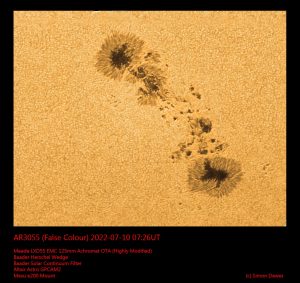
Making a Solar Filter for my Skywatcher 190MN
NEVER LOOK AT THE SUN DIRECTLY. Please click here for solar observing safely.
My Skywatcher 190MN telescope has a very wide field of view I can easily fit the full Moon or Sun on the chip, so I thought I’d get myself some Baader solar Safety Film and make myself a solar filter – the video below shows how i made it and shows some early results. Check-out our solar section for more images.
The Sun
The Sun on the 14th May 2022 taken by member & trustee Simon Dawes.
NEVER LOOK AT THE SUN DIRECTLY. Please click here for solar observing safely.

The Sun – 8th & 9th May 2022 by Simon Dawes
Two more great images of our Sun on the 8th & 9th May 2022 by Simon Dawes and now up to Sunspot number AR3007.
Sunspot AR3006 however is behaving a bit odd as described on Spaceweather.com ”A MIXED-UP SUNSPOT: Sunspot AR3006 is having an identity crisis. It is supposed to have a +/- magnetic field. Mostly it does. But deep inside the sunspot’s primary core, the polarity is opposite: -/+…………….The mixture of magnetic polarities makes this sunspot interesting and dangerous. When opposite polarities bump together, it can light the fuse of magnetic reconnection–the explosive power source of solar flares. If AR3006 flares today, it will be geoeffective. The sunspot is directly facing Earth.”
NEVER LOOK AT THE SUN DIRECTLY. Please click here for solar observing safely.
The Sun 8th May 2022
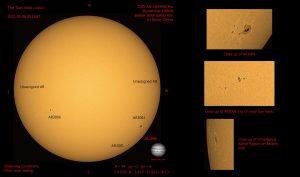
The Sun 9th May 2022

The Sun – 6th May 2022
The latest image of the Sun taken by Simon Dawes.
NEVER LOOK AT THE SUN DIRECTLY. Please click here for solar observing safely.

The Sun by Simon Dawes
The Sun on the 30th April 2022 taken by Simon Dawes. As you can see the Sun was still ‘active’ re sunspots on that day.
As of today (5th May) we are now up to AR3006 and in the past 24 hours sunspot AR3004 has produced over 18 solar flares (15+ C-class flares and 3 M-flares).
NEVER LOOK AT THE SUN DIRECTLY. Please click here for solar observing safely.
The Sun on the 30th April 2022

Sunspots AR2993 & AR2994 by Kevin Langford
Superb close up of Sunspots AR2993 & AR2994 captured by member Kevin Langford on the 24th April 2022 using ASI385mc, SW 130 Reflector on a SW Adventure tracker mount. Using SharpCap, Autostakkert 2 and PS.
NEVER LOOK AT THE SUN DIRECTLY. Please click here for solar observing safely.

Spotty Sun
More sunspots!!!!
Now up to AR2999 and counting as there is now a new very active region of sunspots appearing on the Sun as of today which have yet to be given an AR number.
This new source of solar activity has so far been of C-class explosions which have in the past 24 hours hurled at least two CMEs into space. We (Earth) are not yet in the line of fire but as the active region rotates toward facing our planet things could change……
Simon Dawes captured these 2 white light image of the Sun on the 24th & 26th April 2022.
NEVER LOOK AT THE SUN DIRECTLY. Please click here for solar observing safely.
The Sun on the 24th April 2022

The Sun on the 26th April 2022

Active Sun
And they keep coming………more sunspots appearing on the Sun as captured by Simon Dawes on the 23rd April 2022. Now up to sunspot AR 2996 on Simon’s image below but as of 24th April – sunspot AR 2997 has put in an appearance.
NEVER LOOK AT THE SUN DIRECTLY. Please click here for solar observing safely.

The Sun by Simon Dawes
Nice to see some sunspots on the Sun and there are quite a few visible at the moment as Simon Dawes shows in his recent images taken of the Sun on the 20th & 21st April 2022. NEVER LOOK AT THE SUN DIRECTLY. Please click here for solar observing safely.
Sunspot complex AR2993-94 is crackling away with M-class solar flares and did directly face Earth a day later. They are ‘big’ sunspots too. The two dark cores are as large as Earth and a magnetic filament attached to one of the cores is more than 100,000 km long.
Sun on 20th April 2022

Sun on 21st April 2022

Sunspots are caused by magnetic disruptions of the visible photosphere of the sun which exposes the relatively cooler layers underneath – appearing as a black spot.
The sun’s magnetic entanglements and disentanglement happen in 11-year cycles with each solar cycle having phases of low and high activity. Solar activity cycles have been numbered since 1775, when extensive recording of sunspot activity began.
We are currently in Solar Cycle 25, which has yet to reach its peak. The current cycle is expected to reach its maximum activity in late 2024 or early 2025, this means we may see more and bigger sunspots.
The Sun – 3rd April 2022
A superb image of an ‘active’ Sun by Simon Dawes taken from Bexleyheath. Details of how Simon took the photo are on the image.

The Sun – 25th March 2022
A lovely image of the Sun showing 3 sunspots taken by Simon Dawes on the morning of the 25th March 2022 from Bexleyheath. Details of how Simon acquired the image is on the photo.

The Sun – 23rd March 2022
Another great image of the Sun by Simon Dawes taken today from Bexleyheath. Details of how the image was acquired is written on the photo. Three sunspot groups are visible.

The Sun – 18th March 2022
A very nice image of the Sun with sun spots taken by Simon Dawes on the morning of the 18th March 2022 from Bexleyheath. Taken using a Baader solar safety filter, skywatcher 190mn telescope, ZWO ASI1600mm pro CMOS camera, mesu e200 MkII mount and sharpcap pro image capture software.

Solar Images By Leigh Slomer
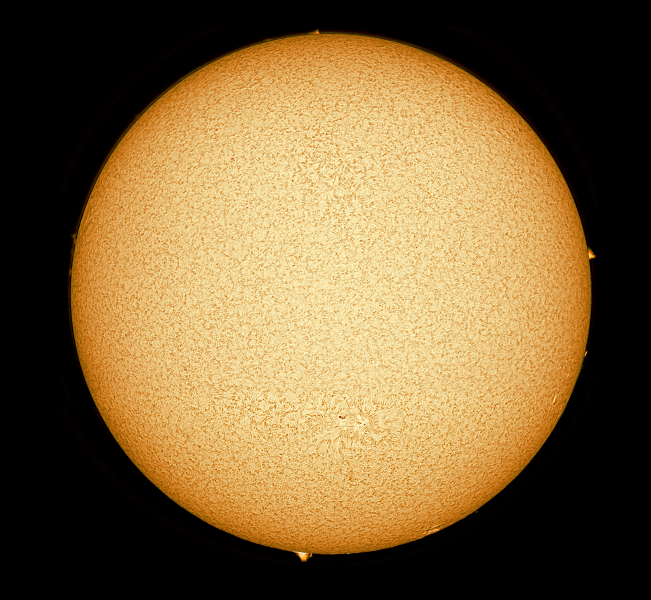

Sun spots! 2020-12-27
Images by Honor Wheeler


ISS transit of the Sun
Honor recently took this video of a transit of the Sun by the ISS, something she has been attempting for 10 years.

Cycle 25 Sun Spots

Transit of Mercury, 11th November 2019
Despite the poor weather our members were out in force observing the transit of Mercury across the face of the Sun, something that has to be done carefully to be safe.



Solar Observing at Hall Place Summer 2019
A big thanks to everyone who supported both of the recent Hall Place Solar Observing events which were an exciting mixture of hide and seek as far as the sun was concerned, but both in their own way very successful.
We had sideways rain at 1100 yesterday (18th August 2019), so we set displays up indoors for about half an hour, after which we relocated outside and never looked back.
Even the sun cream got an airing!
It was very encouraging to meet a couple of extremely bright 8 year olds asking / answering some great questions – future members I’m sure.
These things don’t happen by accident so for anyone who supported the two events with equipment, transport, setting up or engaging with the public, a huge thank you.
We will be back in the Winter for the pre- and post- Christmas Stargazing events and should consider any suggestions / fresh ideas to make these as engaging and informative as possible.
Once again, your support is greatly appreciated.
John (Chair)


Solar Observing at Hall Place – August 2018
The Society were at Hall Place on Sunday 19 August 2018 showing members of the public the Sun using safe observing techniques and talking to people about Astronomy in general. Whilst there was a fair amount of cloud about and the Sun was playing ‘hide-and-seek’ the day was a massive success.
The Society were at Hall Place on Sunday showing members of the public the Sun using safe observing techniques and talking to people about Astronomy in general. Whilst there was a fair amount of cloud about and the Sun was playing ‘hide-and-seek’ the day was a massive success.
Solar Images by Martin Crow
Solar Images by Shelley Filippi
Solar Images by Simon Dawes
Solar Images by Keith Rickard
Solar Images by Julian Tworek
Andy Smith’s Solar Images
Honor Wheeler’s Solar Images
Andy Barber’s Solar Images
Solar Slideshow
Other Images
Sun | Comets | Mercury | Venus | Atmospheric Optics | Meteors | Auroa and NLC | Moon | Minor Planets | Mars | Jupiter | Saturn | Uranus | Neptune | Messier | Caldwell | All Deep Sky | Conjunctions | Transits | Solar Eclipse | Lunar Eclipse | Wide Field |ISS & Space Junk | Exo-Planets
All images are copyright. Permission must be sought to from the image owner to the use of any of these images.










